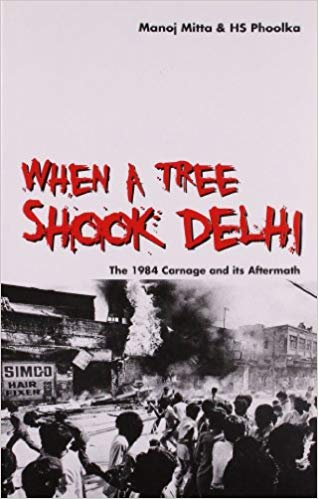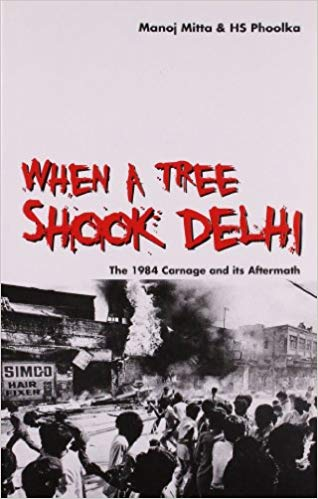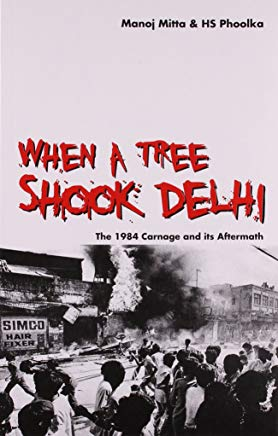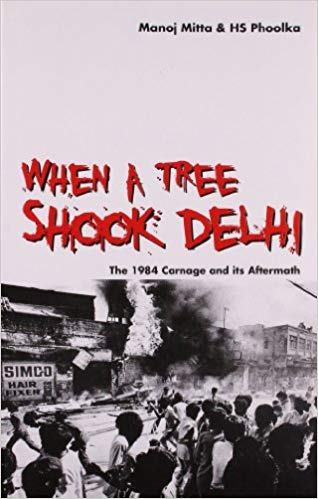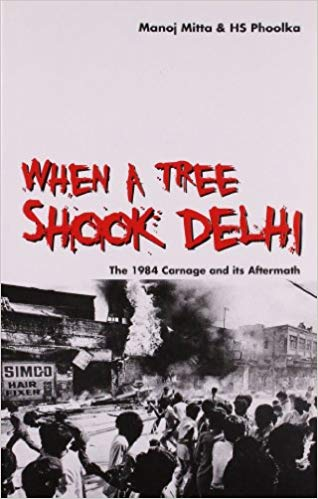I had started to write a review of @hsphoolka& #39;s book, "When A Tree Shook Delhi: The 1984 Carnage and its Aftermath".
I never finished it, but here are some thoughts and excerpts from the book.
These are fairly disturbing.
1/
https://amzn.to/2JsrY60 ">https://amzn.to/2JsrY60&q...
I never finished it, but here are some thoughts and excerpts from the book.
These are fairly disturbing.
1/
https://amzn.to/2JsrY60 ">https://amzn.to/2JsrY60&q...
In the long and sordid saga of communal violence and riots that have shaken India after Partition, the sheer brutality and one-sidedness of the 1984 anti-Sikh riots stands apart.
2/
2/
Unlike almost every other riot in post-Partition India where there were reprisals from one side where the other was the initiator, the 1984 riots were entirely one-sided.
3/
3/
Nor were the 1984 riots communal in nature to the extent that the perpetrators were united by religion - these were criminals given a free reign by the police and political class.
https://amzn.to/2JsrY60
4/">https://amzn.to/2JsrY60&q...
https://amzn.to/2JsrY60
4/">https://amzn.to/2JsrY60&q...
That, and the fact that ordinary Hindus came together to defend their Sikh brethren from the marauding gangs of criminals, looters, murderers, and rapists that rampaged through Delhi. It is also a fact that almost all these perpetrators belonged to one political party.
5/
5/
In 2015, a video of that statement was released by Phholka.
"... Phoolka said that it was difficult to get the video of the speech as the same was deleted from the records and archives of Doordarshan and it was retrieved with much difficulty." https://indianexpress.com/article/india/india-news-india/video-of-rajiv-gandhis-infamous-tree-falls-comment-released-by-aap-bjp-leaders/
6/">https://indianexpress.com/article/i...
"... Phoolka said that it was difficult to get the video of the speech as the same was deleted from the records and archives of Doordarshan and it was retrieved with much difficulty." https://indianexpress.com/article/india/india-news-india/video-of-rajiv-gandhis-infamous-tree-falls-comment-released-by-aap-bjp-leaders/
6/">https://indianexpress.com/article/i...
"In his affidavit before the Nanavati Commission,Gulati specified that the mob was led by local Congress Party councillor, Arjan Dass.
If the police did not take cognizance of the attacks on President Zail Singh, what chance did lesser Sikhs have of being protected from rioters?"
If the police did not take cognizance of the attacks on President Zail Singh, what chance did lesser Sikhs have of being protected from rioters?"
"There again, Congress Party workers were the culprits. They ran amok from around 11.00 am, beating up Sikhs in several parts of Kolkata. The army was deployed in Kolkata by 2.30 pm on 31 October."
8/
8/
"Acting in tandem, Assistant Commissioner Kewal Singh and Inspector Gurmail Singh registered FIR No 633 at 8.10 pm after rounding up ninety rioters... Both were pulled out of action the same night, before they could do any further damage to the morale of the mobs."
9/
9/
"they were visited by Additional Commissioner Hukum Chand Jatav... Jatav, while deposing before the Misra Commission on 24 April 1986, stated that Kewal Singh and Gurmail Singh were ‘guilty of abandoning their positions of duty during the riots.& #39;"
10/
10/
"As for attacks on person, they were limited to turbans being pulled down and burnt, or Sikhs being dragged out of vehicles and beaten up. Significantly, none of the FIRs related to the mass violence of 31 October refers to murder."
11/
11/
"The killings began only the next morning... The killings were concentrated in areas where the poorest of the Sikhs lived. It was the outlying police stations of Kalyanpuri, Mongolpuri, Sultanpuri, and Delhi Cantonment that witnessed mass murders on an unprecedented scale."
12/
12/
"...2,733 Sikhs are officially estimated to have perished (while the death toll arrived at by the Citizens Justice Committee was 3,870)."
13/
13/
"Throughout the thirty-minute meeting that took place while Delhi was burning, Jethmalani was struck by the fact that the home minister was not in contact with any of his officers, whether on the telephone or in person."
14/
14/
"But the Sikhs living in Block 11 of Kalyanpuri in east Delhi in 1984 were an exception. For despite their poverty, a lot of them owned firearms, complete with licence and ammunition. Those Sikhs belonged to a little-known section called Sikligar."
15/
15/
"The mob, despite its frenzied slogans to avenge Indira Gandhi’s murder, beat a hasty retreat. It was a tactical retreat, though. Within minutes, the police entered the same neighbourhood."
16/
16/
"But their intention was not to save the Sikhs from further attacks. [it was]; to disarm the besieged community. Flanked by armed constables, the chief of the Kalyanpuri police stn, Soor Veer Singh Tyagi, read out from a list he had brought with him, of licensed weapon holders."
"Out of the 2,733 Sikhs killed in Delhi in the first week of November 1984, 1,234 were killed in east Delhi alone."
18/
18/
"Though more than half of those killings took place on 1 November, only twenty-six people were arrested in east Delhi on that fateful day, and all of them were Sikhs, that is, members of the very community that was being massacred."
19/
19/
"Hukam Chand Jatav, walked into the room at that point, saying that he had just returned from a tour of east Delhi, which happened to be one of the three districts under his jurisdiction."
20/
20/
"‘Shanti’ prevailed in the whole of east Delhi, Jatav claimed, adding for good measure, ‘particularly Trilokpuri.’"
21/
21/
"Soor Veer Singh Tyagi himself rushed to the spot with armed policemen But, rather than dispersing the miscreants, Tyagi ordered the Sikhs to return to their homes, saying that it was his responsibility to protect them."
22/
22/
"The moment the Sikhs dispersed, the mob led by local Congress leaders Rampal Saroj and Dr Ashok Gupta broke into smaller groups and pounced on their houses."
23/
23/
"None of the police officers accountable for the Block 32 massacre – Tyagi, Sewa Dass and Jatav – was penalized, whether in criminal cases or through departmental proceedings. All of them went on to get their promotions, more than once, in their careers."
24/
24/
"Their crowning glory was that the Nanavati Commission did not indict any of the police personnel associated with east Delhi, despite being the worst affected district in the carnage."
25/
25/
"As a result, Sewa Dass retired ‘honourably’ as special commissioner of Delhi Police, almost at the top of the hierarchy, within three months of the publication of the Nanavati report."
26/
26/
"The attack on Rakab Ganj Gurdwara was also remarkable for the fact that it was probably the first, and so far, the only instance in the history of mass violence in India, where a political leader admitted to being on the spot."
27/
27/
"In separate incidents, journalists saw Tytler and Shastri barging into the presence of senior police officers and trying to browbeat them into releasing Congress Party workers who had been arrested."
28/
28/
"Pareira ordered firing. He got his men to open fire on the miscreants who were looting a shoe shop owned by Sikhs. Constable Shiv Prashan of Kotwali police station opened fire on his order."
29/
29/
"Shiv Prashan fired three rounds, shooting one person dead in full view of the rioters. Driving home the rule of law, Pareira announced then and there, a reward of Rs 200 to the constable, making sure the reward was heard by everyone as he announced it on a loud-hailer."
30/
30/
"The firing and the reward had the desired – and expected – effect. Sis Ganj Gurdwara was saved as the mobs melted away."
31/
31/
"Sanjay Suri, in his report, as also in his affidavit before the Misra Commission, and oral deposition before the Nanavati Commission. Suri found that Kamal Nath was ‘controlling the crowd’ which he said was& #39;looking to him for directions.’"
32/
32/
"Sajjan Kumar, who has been accused of leading mobs during the carnage in the most number of affidavits, secured the maximum votes in the whole country – 8,55,543 – when he won from his outer Delhi constituency in the last Lok Sabha election in 2004."
33/
33/
"Tyagi really opened up to me in a bid to convince me that he had been made a scapegoat. In a sensational disclosure, he said that the massacre was the result of a conspiracy hatched on the evening of 31 October in Bhagat’s house."
34/
34/
"According to Tyagi, it was a secret meeting attended by senior police officers from east Delhi, including Jatav. The decision conveyed to officials down the line was to let the killings take place and then erase all traces of the crime."
35/
35/
"he was the only one to have got into trouble, and that was because of one vital mistake on his part. He failed to dispose off the dead bodies. In other places, most of the corpses were either reduced to ashes or dumped elsewhere."
36/
36/
"Tyagi’s explanation for allowing bodies to pile up in Block 32 of Trilokpuri was that there were simply too many of them in that locality. ... Tyagi has since been promoted, and last heard of, he was assistant commissioner of police."
37/
37/
"From the evidence that came to light, I dare say that Jugti Ram could be credited for the rescue of about thirty female Sikhs from Trilokpuri, however belatedly, from the clutches of a mob that had abducted them from Trilokpuri on 1 November."
38/
38/
"Rajiv Gandhi brushed aside inquiry demands saying, for instance, to India Today in January 1985 that it would only rake up ‘issues that are really dead’."
"Misra had anyway allowed access to an array of lawyers representing groups that were avowedly anti-victim."
39/
"Misra had anyway allowed access to an array of lawyers representing groups that were avowedly anti-victim."
39/
"Those groups, operating under deceptive names such as Citizens Forum for Truth, Citizens Committee for Peace and Harmony, and Nagrik Suraksha Samiti..."
40/
40/
"the lawyers representing those anti-victim groups received advance information ... about when each victim was due to depose. ... those groups were actually proxies for culprits, as they were using that information to try and intimidate the victims just before their deposition."
"such extraordinary partisanship did not go unrewarded. Misra was rewarded twice since he retired as chief justice of India. In 1993, the Congress government of PV Narasimha Rao appointed him as the first chairman of, ironically enough, the National Human Rights Commission."
42/
42/
"Next, dropping all pretence of impartiality, Misra became a Rajya Sabha member of the Congress Party."
43/
43/
"The first sign he gave of his dubious intentions, as mentioned in the earlier chapter, was his decision to hold the entire inquiry in camera."
44/
44/
" Next, we saw that he used the veil of secrecy to hide from the public the flood of identical affidavits claiming that Delhi Congress leader HKL Bhagat, far from organizing the carnage, had helped the Sikhs in their hour of need."
45/
45/
"Misra made a more blatant attempt to co-opt me. He said that if I accepted his offer to participate in the inquiry, he would, in turn, see to it that I was ‘suitably rewarded.’"
46/
46/
"High Court, which was still being administered by Chief Justice RN Pyne, who had been, as explained in the previous chapter, especially transferred to the capital during Rajiv Gandhi’s reign, to shield Sajjan Kumar."
47/ http://amzn.to/2JsrY60 ">https://amzn.to/2JsrY60&q...
47/ http://amzn.to/2JsrY60 ">https://amzn.to/2JsrY60&q...
"I may add that we still remember the few months that Chandra Shekhar and Markandey Singh were in charge as the golden period of our struggle for justice."
48/
48/
"In retrospect, we should not have been surprised at the commitment shown by Chandra Shekhar. After all, he was about the only major political leader to have intervened openly while the carnage was still on."
49/
49/
"...Chandra Shekhar had participated in a long peace march through Delhi on 2 Nov& #39;84. He deserved a great deal of credit for not giving up his concern for the riot victims six years later, even though the Congress Party’s support was indispensable to the government he had formed"
"while Congress leaders ... were unabashedly shielding the perpetrators of the 1984 carnage, Khurana, who made no bones about his association with a Hindu supremacist ideology, proved to be more sincere in seeking justice for the victims of that sectarian violence."
51/
51/
"SN Dhingra, the judge dealing with cases from east Delhi, the worst affected district in the carnage, struck a blow for the rule of law by deciding carnage cases, without fear or favour. Dhingra alone convicted over 150 persons in carnage cases."
52/
52/
"She said that on the night of 31 October, she had seen Bhagat telling a crowd in her neighbourhood that the police would ‘not interfere for three days& #39;, & those people were therefore at liberty to ‘kill every Sikh’ and do their ‘duty to Bharat Mata’."
53/
https://amzn.to/2VqMVp2 ">https://amzn.to/2VqMVp2&q...
53/
https://amzn.to/2VqMVp2 ">https://amzn.to/2VqMVp2&q...
"The matter came up for hearing on 22 January, three days ahead of the date on which Bhagat was due to be arrested and produced in Dhingra’s court. At the outset, the High Court judge, Justice Jaspal Singh, objected to the personal allegations against Dhingra, in the petition."
"In a stern warning, Justice Singh told Bhagat’s counsel, RK Anand, that he would have to withdraw the allegations, or be prepared to face contempt proceedings. It was only after Anand withdrew the allegations did Justice Singh begin to hear the matter on merits."
55/
55/
"... Justice Singh, who has authored several law books, was thoroughly prepared for the case. Whenever Anand quoted a judgment in his favour, Justice Jaspal Singh would promptly summarize its details and draw the lawyer’s attention to a particular paragraph that went against him"
"As Anand could not counter that, the High Court dismissed Bhagat’s petition. It turned out to be such a well-reasoned judgment that Bhagat did not take the risk of going to the Supreme Court."
57/
57/
"Bhagat stood on his chair because that was the only way he could, given his short stature, make himself visible in that overcrowded room. Then he greeted the judge with a ‘namaskar’ in a tone that sounded more like a taunt."
58/ http://amzn.to/2JsrY60 ">https://amzn.to/2JsrY60&q...
58/ http://amzn.to/2JsrY60 ">https://amzn.to/2JsrY60&q...
"Dhingra ignored him because, according to court protocol, the judge had already bowed once and greeted everybody present in the court. He was not expected to greet every individual separately, especially not an accused person."
59/
59/
"Bhagat said ‘namaskar’ once again, this time more loudly than before. When even that failed to evoke a reaction from the judge, Bhagat said sarcastically, ‘Namaskar to le lo’ (accept my greetings, at least). He was obviously trying to provoke the judge."
60/
60/
"‘Don& #39;t you dare greet me,’ he [Dhingra] thundered, ‘as if you are throwing a stone at me.’ Turning to Anand, the judge told him to ask his client to behave. Anand and other lawyers reacted with alacrity, as if Dhingra had played into their hands."
61/
https://amzn.to/2Ju5ukW ">https://amzn.to/2Ju5ukW&q...
61/
https://amzn.to/2Ju5ukW ">https://amzn.to/2Ju5ukW&q...
"After hearing arguments from both sides on Bhagat’s bail application, Dhingra reserved his order. That set the stage for Bhagat to start another drama. As if on cue, Bhagat complained that he had chest pain and lay down on a table in the court room."
62/
62/
"In May 2004, the police reported that they could not execute the warrants because Bhagat has since been afflicted by a brain disease, dementia. Justice Sodhi dismissed our petition, as Bhagat was in no condition to face legal proceedings."
"Bhagat’s son, Deepak, came up to me in the High Court and said, ‘Please spare my father at least now. He is on his death bed.’ I was tempted to give a fitting retort. But decency, & my seniority in the bar, stopped me from saying anything to Deepak"
https://amzn.to/2Ju5ukW
64/64">https://amzn.to/2Ju5ukW&q...
https://amzn.to/2Ju5ukW
64/64">https://amzn.to/2Ju5ukW&q...

 Read on Twitter
Read on Twitter